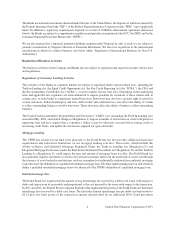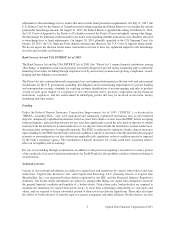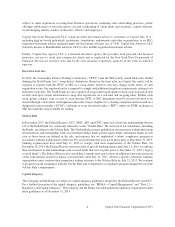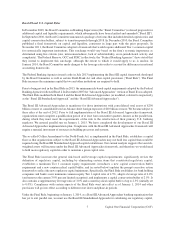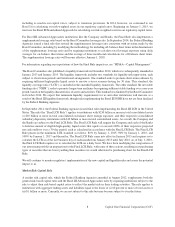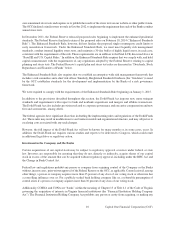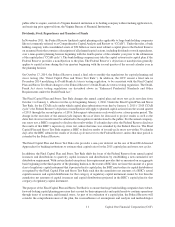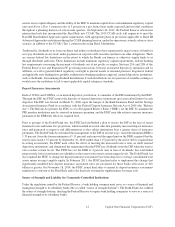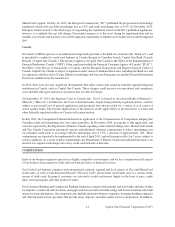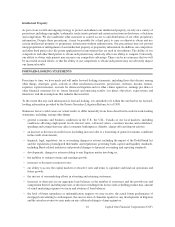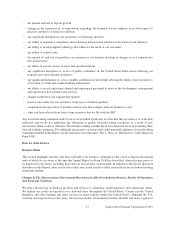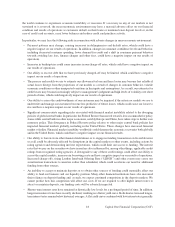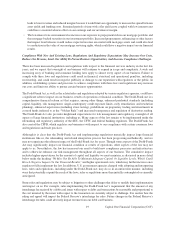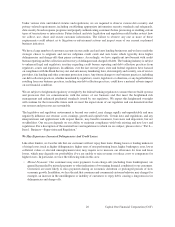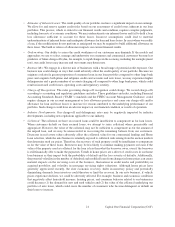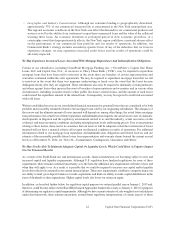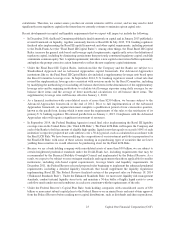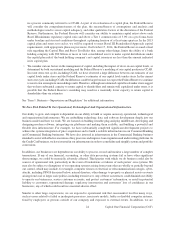Capital One 2014 Annual Report Download - page 36
Download and view the complete annual report
Please find page 36 of the 2014 Capital One annual report below. You can navigate through the pages in the report by either clicking on the pages listed below, or by using the keyword search tool below to find specific information within the annual report.
MasterCard’s appeal. On July 24, 2013, the European Commission (“EC”) published the proposed new Interchange
regulations which will cap debit interchange fees at 0.2% and credit interchange fees at 0.3%. In November 2014,
European leaders moved to the final stages of negotiating the regulations based on the EC’s published regulations;
however, it is unlikely the cap will change. Uncertainty remains as to the exact timing for implementation and on
whether cross-border and domestic rates will be imposed concurrently or whether cross-border rates would be imposed
first.
Canada
In Canada, COBNA operates as an authorized foreign bank pursuant to the Bank Act (Canada) (the “Bank Act”) and
is permitted to conduct its credit card business in Canada through its Canadian branch, Capital One Bank (Canada
Branch) (“Capital One Canada”). The primary regulator of Capital One Canada is the Office of the Superintendent of
Financial Institutions Canada (“OSFI”). Other regulators include the Financial Consumer Agency of Canada (“FCAC”),
the Office of the Privacy Commissioner of Canada, and the Financial Transactions and Reports Analysis Centre of
Canada. Capital One Canada is subject to regulation under various Canadian federal laws, including the Bank Act and
its regulations, the Proceeds of Crime (Money Laundering) and Terrorist Financing Act and the Personal Information
Protection and Electronic Documents Act.
In 2014, there were two new significant developments that affect credit cards issued by federally regulated financial
institutions in Canada, such as Capital One Canada. These changes could increase our operational and compliance
costs and affect the types and terms of products that we offer in Canada.
On September 19, 2014, the Supreme Court of Canada (the “Court”) released its decision in Bank of Montreal v.
Marcotte (“Marcotte”). In Marcotte, the Court stated that banks, despite being federally-regulated entities, could be
subject to provincial laws of general application and provincial laws that provided for a variety of civil causes of
action against banks. The broader implications of the decision on the applicability of provincial law to banks and
other federally-regulated entities in Canada still remain unclear.
In July 2013, the Competition Tribunal dismissed an application of the Commissioner of Competition alleging that
Canadian credit card interchange fees were anti-competitive. In November 2014, in response to this application, and
concerns expressed by the Department of Finance Canada regarding credit card interchange rates, MasterCard Canada
and Visa Canada Corporation announced separate and individual voluntary commitments to reduce interchange rates
for consumer credit cards to an average effective interchange rate of 1.5%, a decrease of approximately 10%. These
commitments are expected to be implemented by the end of April 2015, and will remain in effect for 5 years, subject to
certain conditions. As a result of these commitments, the Department of Finance Canada has indicated that there is no
need for it to regulate interchange rates set by credit card networks at this time.
COMPETITION
Each of our business segments operates in a highly competitive environment, and we face competition in all aspects
of our business from numerous bank and non-bank providers of financial services.
Our Credit Card business competes with international, national, regional and local issuers of Visa and MasterCard
credit cards, as well as with American Express®, Discover Card®, private-label card brands, and, to a certain extent,
issuers of debit cards. In general, customers are attracted to credit card issuers largely on the basis of price, credit
limit, reward programs and other product features.
Our Consumer Banking and Commercial Banking businesses compete with national and state banks and direct banks
for deposits, commercial and auto loans, mortgages and trust accounts and with savings and loan associations and credit
unions for loans and deposits. Our competitors also include automotive finance companies, mortgage banking companies
and other financial services providers that provide loans, deposits, and other similar services and products. In addition,
14 Capital One Financial Corporation (COF)


